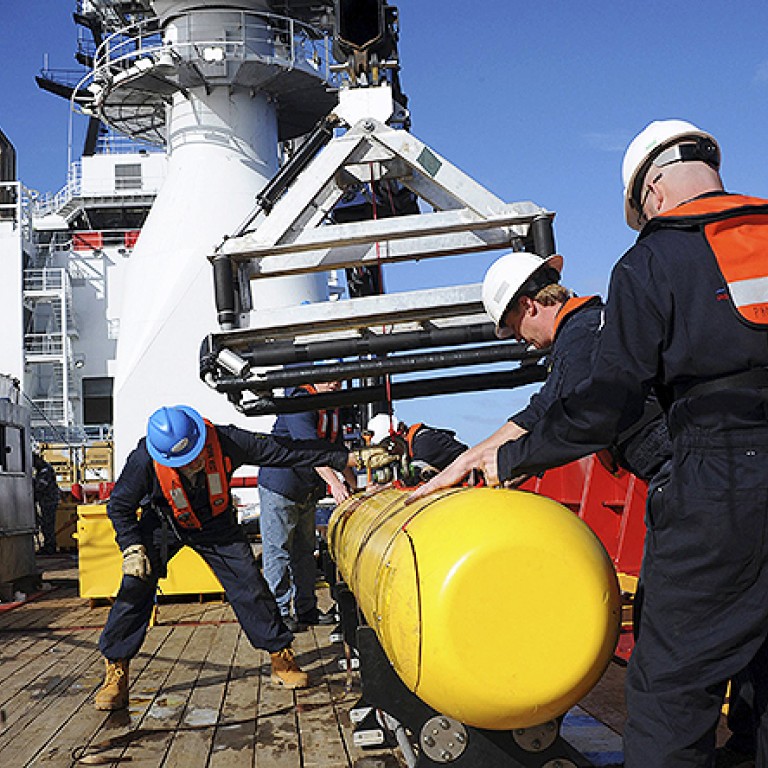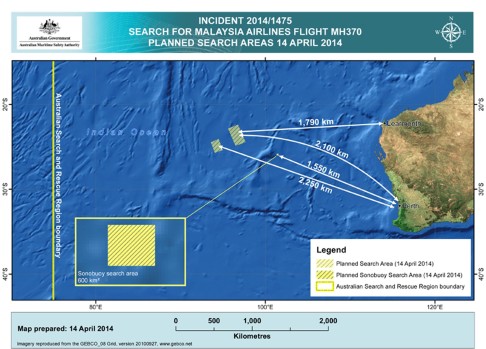
Submarine hunt for MH370 aborted after water proves to be ‘too deep’
A robotic submarine sent into the Indian Ocean to scour for evidence of missing flight MH370 was hauled back from its first mission after waters in the search zone proved to be too deep.
A robotic submarine sent into the Indian Ocean to scour for evidence of missing flight MH370 was hauled back from its first mission after waters in the search zone proved to be too deep.
Search crews sent the Bluefin 21 deep into the Indian Ocean late Monday to begin searching the seabed for the missing Malaysia Airlines Boeing 777.
But after only six hours of its planned 16-hour mission on the seabed, the autonomous underwater vehicle exceeded its maximum depth limit of 4,500 metres and its built-in safety feature returned it to the surface, the search coordination center said in a statement on Tuesday.
Watch: Mini-sub tries again after first search for MH370 aborted
“The six hours of data gathered by the Autonomous Underwater Vehicle is currently being extracted and analysed,” the statement said.
US Navy Captain Mark Matthews explained the vehicle had exceeded its programmed operational limit and automatically resurfaced.
“There’s certain abort criteria that the vehicle has as it’s executing its mission,” he told CNN from Perth.

Charts put the depth at 4,200-4,400 metres, he said.
“It went to 4,500 metres and once it hit that max depth, it said this is deeper that I’m programmed to be, so it aborted the mission.”
The search area will now be shifted to what is thought to be shallower water, he added.
The Bluefin 21 had replaced the "towed pinger locator" that was being pulled along by the ship Ocean Shield in an attempt to trace signals from the Boeing 777's black boxes.
Four possible signals were detected from April 5 to 8, but after six days of silence experts fear the batteries from the flight recorders may have died.
Angus Houston, who is heading the search operation, said yesterday: "We haven't had a single detection in six days so I guess it's time to go underwater."
The submarine was due to use sonar technology to compose a high-resolution 3D map of the seabed, which should reveal any wreckage on the ocean floor.
But it is built to operate at a maximum depth of 4,500 metres - the approximate depth of the ocean in the area that the search teams are targeting.
Houston warned it would be a "slow and painstaking process", with the craft covering just 40 square kilometres in each 24-hour period.
He described the ocean floor at the search site, where the plane and 239 people onboard may have come to rest, as "an area new to man".
"It's not sharply mountainous or anything, it's more flat and almost rolling, but we understand ... that part of the Indian Ocean has a lot of silt. That will complicate how things are on the bottom."
Meanwhile, Houston revealed that the crew of the Ocean Shield had detected an oil slick approximately 5.5 kilometres downwind from the vicinity of the "pings" heard last week. Two litres of the oil have been scooped up for analysis, although it will be several days before the sample can be taken ashore and tested.
